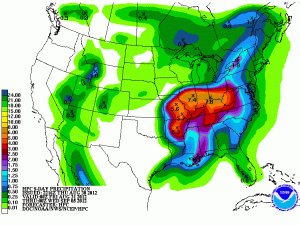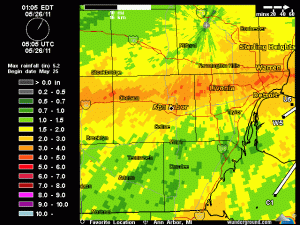The city of Boulder, Colorado is flooded after several days of torrential rains. Here’s some useful links if you want to get up to speed on what’s going on.
Turn around, don’t drown. If you’re in the affected area, get authoritative news from local sources (and not this blog).
Scanner
For raw unfiltered news of what is happening, listen to the emergency services scanner for the Boulder area. The Boulder County Sheriff and Fire feed has over 800 listeners as of this writing. You’ll want to listen through headphones, because the feed is a stereo feed with fire/rescue on one channel and police on the other.
A good text counterpart to this is the Boulder Office of Emergency Management twitter feed, which has brief and authoritative updates about the situation. The Boulder OEM web site echoes those updates in more detail.
Local news media
The Daily Camera is Boulder’s daily newspaper, and it has continuous updates on the situation. Their September 12 story is a long list of incidents, warnings, accounts and stories about what’s going on. Twitter: @dailycamera
There’s flooding in the Denver area as well, and the Denver Post is on it. A September 12 Denver Post story notes the extent of the damage:
Heavy rain and massive flooding threatens towns and cities up and down the Front Range into the day Thursday as communities were evacuated, roads closed and emergency shelters set up.
Three people were confirmed dead and at least one missing.
At an afternoon news conference Boulder officials said at least 12 dams in the county had overflowed.The Boulder airport was closed as well as Boulder mountain parks and open space until further notice.
As ever, Twitter is on the scene when there’s news. The #boulderflood and #cowx hashtags have been trending, with photos, video, and brief accounts of what’s happening. A #coflood tag covers flooding across Colorado.
Maps
A map has been removed per the owner’s request on 25 October 2013.
The City of Boulder has a road closures map with markers showing where roads are closed or impassible. Officials are recommending that people stay off the roads.
As of Thursday, September 12 in the evening I have not been able to find a good clear map that shows the full extent of affected areas, and emergency operations are still in rescue mode.
Google has a crisis map for the 2013 Boulder Floods. This is a snapshot as of Friday, September 13, in the morning. The dots mark places where roads are closed, and the evacuation area for Longmont is shown as the St Vrain River bisects the town. Look at the current map for the latest details, and know that roads are being opened and closed in response to changing needs.
Cities affected by the flood
This is an incomplete list of towns and villages beyond Boulder that are affected by the flood.
Lyons, Colorado: Photos on Facebook at the Lyons, Colorado page and at Kenneth Wajda’s site I Am Lyons Colorado.
A National Weather Service alert warns of flash flooding hazards in Lyons, Jamestown, Peaceful Valley, Allenspark, Raymond, Meeker Park and Longs Peak.
Another alert warns for flooding in the following locations: Northwestern Arvada, Western Westminster, Boulder, Western Longmont, Southwestern Broomfield, Lafayette, Louisville. Superior, Lyons, Jamestown, Salina, Eldorado Springs, Crisman. Gold Hill, Niwot, Summerville, wallstreet, Rocky Flats. Raymond, sunshine, white Ranch open space and Allenspark.
The Jefferson County Sheriff has emergency information on a Blogspot weblog.
KRDO has a log of Colorado Springs flooding information.
Water levels
The Boulder Creek hydrograph shows current water levels measured in Boulder. As of this writing the creek is in “moderate flood stage” and rising.
History
This flood is being compared to the 1894 Boulder flood. The Boulder History Museum account of that flood reads in part:
As rains continued, adding to spring runoff, Boulder Creek began to rise. The threat of a flood was serious. Overnight, the creek rose out of its banks and rushed through the canyons above Boulder. By daybreak the creek had turned into an angry river, carrying debris from the settlements and bridges it destroyed in the mountains. In Boulder, the creek had begun its destruction as it swept the Sixth and Twelfth Street bridges downstream. The flood submerged railroad tracks, roads and farms, and tore down telephone and telegraph poles, taking Boulder’s means of transportation and communication out of commission.



































